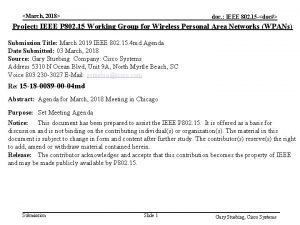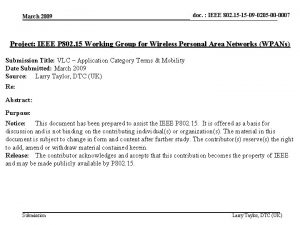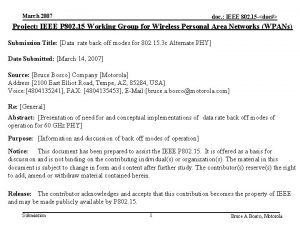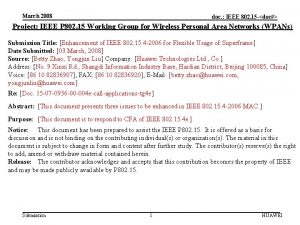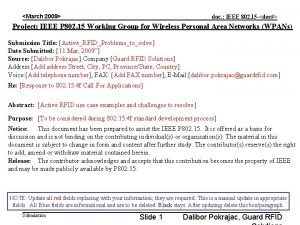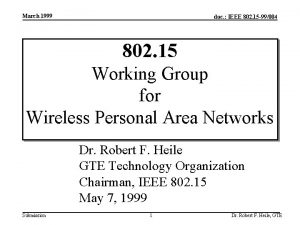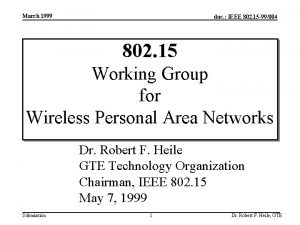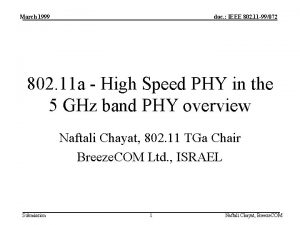March 2018 doc IEEE 802 11 180381 r







![March 2018 doc. : IEEE 802. 11 -18/0381 r 1 References [1] IEEE 802. March 2018 doc. : IEEE 802. 11 -18/0381 r 1 References [1] IEEE 802.](https://slidetodoc.com/presentation_image_h2/71d9d634bfb69b9041f5950d6158aa5a/image-8.jpg)



- Slides: 11

March 2018 doc. : IEEE 802. 11 -18/0381 r 1 Association after Beamforming in mm. Wave Distribution Networks Name Affiliation Address Djordje Tujkovic Facebook 1 Hacker Way Menlo Park, CA 94025 Nabeel Ahmed Submission Phone Email djordjet@fb. com nabeel@fb. com Dong Zheng dongzheng@fb. com Praveen Gopala gopalap@fb. com Payam Torab ptorab@fb. com Michael Grigat Deutsche Telekom Deutsche-Telekom-Allee 7, 64372 Darmstadt, Germany m. grigat@telekom. de Nikolas Olaziregi Nokia Copernicuslaan 50 2018 Antwerp, Belgium nikolas. olaziregi@nokia. com 1 Djordje Tujkovic et al.

March 2018 doc. : IEEE 802. 11 -18/0381 r 1 Background • • Beamforming in Distribution Networks Beamforming for Distribution networks has been discussed in [1, 2, 4]; extension to group beamforming (multiple responders) is under study [3] Unlike beamforming in other use cases, end of beamforming is decided administratively, through “End of Training” field in TDD SSW frames In particular, at the completion of initial beamforming (TDD SSW Ack with “End of Training” field set to 1), Initiator and Responder have established a periodic two-way channel access to exchange additional frames without Responder knowing the Initiator’s slot structure or schedule The offset and period of these transmit/receive opportunities are embedded in the terminating TDD SSW Ack frame [7] Bits : Decoded TX Sector ID 10 Count Index Transmit Period SNR Report Initiator Transmit Offset 3 8 8 8 Responder Transmit Offset 8 Reserved 3 Figure 16—TDD Beamforming Information field format (TDD SSW Ack) Submission 2 Djordje Tujkovic et al.

March 2018 doc. : IEEE 802. 11 -18/0381 r 1 Association after initial beamforming TDD slot allocation for Responder (1) • Established transmit opportunities after initial beamforming enable the Initiator to transmit the TDD slots structure and schedule (using TDD Slot Structure and TDD Slot Schedule IEs) to the Responder • When Responder is not connected to the network (e. g. , a new device joining for the first time), Responder’s TDD slot schedule can be decided/assigned unilaterally by the Initiator Unconstrained slot map CN CN Submission DN Initiator (performed by AP/PCP role) Responder (performed by non-AP/non. PCP role) 3 DN New/isolated DN or CN [5] Djordje Tujkovic et al.

March 2018 doc. : IEEE 802. 11 -18/0381 r 1 Association after initial beamforming TDD slot allocation for Responder (2) • There are cases however when Responder may already be connected to one or more Distribution Network nodes – a common scenario is when the link between two Distribution Nodes (DNs) [5] is lost • In such cases, Initiator can better set the Responder’s TDD schedule if it knows the Responder’s availability o Responder’s availability information can be limited to few TDD slots to enable further communication, e. g. , to exchange Keepalive messages for slot allocation through the pipelined scheduling scheme in [6]) Slot map is constrained CN CN CN Submission CN CN DN Initiator (performed by AP/PCP role) Responder (performed by non-AP/non. PCP role) 4 DN DN already serving CN’s CN Djordje Tujkovic et al.

March 2018 doc. : IEEE 802. 11 -18/0381 r 1 Network entry Closer look at network entry steps Initiator (PCP/AP STA in DN) TDD SSW Feedback TDD SSW Ack (End of Training = 1) Announce frame can include both TDD Slot Structure IE and TDD Slot Schedule IE when Responder is isolated (unconstrained slot map) Announce (Action Ack, multiple IEs) Responder (non-AP/non-PCP STA in CN/DN) Beamforming completion Ack Additional Announce frames (if IE’s too big) Ack Association Request provides a good opportunity to communicate TDD slot schedule constraints to Initiator when Responder is not isolated (constrained slot map) Phase I (Timing driven by TDD SSW Ack) Association Response Ack Keepalive/Heartbeat Ack Phase II (Using TDD slots acceptable to Initiator and Responder) (repeated if packet loss) Final schedule can be transmitted in Association Response Keepalive/Heartbeat Ack Phase III (Responder joining the usual bandwidth scheduling process) Continued on next side Submission 5 Djordje Tujkovic et al.

March 2018 Network entry Closer look at network entry steps doc. : IEEE 802. 11 -18/0381 r 1 Initiator (PCP/AP STA in DN) Responder (non-AP/non-PCP STA in CN/DN) Keepalive/Heartbeat Ack (repeated if packet loss) Keepalive/Heartbeat Ack EAPOL Start Ack Phase II (Using TDD slots acceptable to Initiator and Responder) Phase III (Responder joining the usual bandwidth scheduling process) 802. 1 X EAP Request Ack Access Request 802. 1 X EAP Response Ack EAP Authentication Protocol Exchange Access Accept 802. 1 X EAP Success Ack EAPOL-Key (M 1/M 2/M 3/M 4) key exchange Authentication and 4 -way handshake frames are exchanged during normally scheduled slots, and then data frames are unblocked Submission 6 Djordje Tujkovic et al.

March 2018 doc. : IEEE 802. 11 -18/0381 r 1 Conclusions • We suggest to allow a non-AP/non-PCP STA to transmit the TDD Slot Schedule IE to an AP/PCP STA, with TDD Slot Schedule IE interpreted as a set of “available” Tx/Rx TDD slots • TDD Slot Schedule IE interpretation (as decided schedule or as availability) can be implicit (who sends the IE) or explicit (a bit/field in the IE) • TDD Slot Schedule IE can be included in Association Request and Response frames Submission 7 Djordje Tujkovic et al.
![March 2018 doc IEEE 802 11 180381 r 1 References 1 IEEE 802 March 2018 doc. : IEEE 802. 11 -18/0381 r 1 References [1] IEEE 802.](https://slidetodoc.com/presentation_image_h2/71d9d634bfb69b9041f5950d6158aa5a/image-8.jpg)
March 2018 doc. : IEEE 802. 11 -18/0381 r 1 References [1] IEEE 802. 11 -17/1679 “Beamforming protocol reuse for mm. Wave Distribution Networks” [2] IEEE 802. 11 -17/1841 “Beamforming protocol differences for mm. Wave Distribution Networks” [3] IEEE 802. 11 -18/0175 “BF Training enhancement for mm. Wave Distribution Networks” [4] IEEE 802. 11 -18/0179 “Beamforming for mm. Wave Distributed Network” [5] IEEE 802. 11 -17/1321 “Features for mm. W Distribution Network Use Case” [6] IEEE 802. 11 -18/0130 “Link Maintenance in Distribution Networks” [7] IEEE 802. 11 ay Draft 1. 1 Submission 8 Djordje Tujkovic et al.

March 2018 doc. : IEEE 802. 11 -18/0381 r 1 BACKUP SLIDES Submission 9 Djordje Tujkovic et al.

March 2018 doc. : IEEE 802. 11 -18/0381 r 1 Management/data frame exchange timing 3 phases of frame exchange following beamforming • Phase I – Post beamforming (TDD SSW Ack with End of Training = 1) o Exchanges based on Initiator Transmit Offset, Responder Transmit Offset and Transmit Period fields in the TDD SSW Ack frame o Management frames can include Action Ack frames, with Ack frames delayed (transmitted in the following transmit opportunity) • Phase II – After receiving Ack to Association Response that includes a (partially filled) Slot Schedule IE to mark the “control” slots available on Responder side o Exchange period may change from the “Transmit Period” in TDD SSW Ack to the slots marked as TX/RX in Slot Schedule IE (typically more spread out control slots) o “Control slot” is an implementation concept – the Slot Schedule IE simply marks some slots as Tx or Rx, i. e. , polarity concept is also bypassed o “Dummy” Keepalive/Heartbeat message(s) transmitted with schedule bitmap consistent with current control slots (until Initiator receives acknowledgement to the Keepalive/Heartbeat) • Phase III – After Initiator receives the Ack to the first dummy Heartbeat or Keep. Alive message(s) o DN Responder: entering the 3 -stage bandwidth reservation (slot allocation scheme) with Keepalive messages exchanged in both directions o CN Responder: Receiving Heartbeat messages o Remaining security exchanges (authentication, 4 -way handshake) are completed in Phase III Submission 10 Djordje Tujkovic et al.

March 2018 doc. : IEEE 802. 11 -18/0381 r 1 Terragraph Implementation typedef struct _fb. Assoc. Req. Element { /* timestamp and sw. Timestamp are byte arrays to avoid unaligned accesses */ usint 8 timestamp[8]; /* hardware timestamp */ usint 8 sw. Timestamp[8]; /* sw timestamp offset from hw timestamp */ usint 8 rx. Golay. Index : 4; usint 8 tx. Golay. Index : 4; usint 16 frame. Width; usint 16 polarity : 2; usint 16 superframe. Size : 6; usint 16 reserved : 4; usint 16 resp. Node. Type : 2; // Responder Node type: DN or CN usint 8 control. Sf; // Superframe with control slot allocations la. Feedback. Params la. Fb. Params; Vendor. Ie. Element vndr. Ie. El; Meas. Slot. Ie. Element meas. Slot. Ie. El; Caps. Ie. Element caps. Ie. El; Polarity. Ie. Element polarity. El; // NOTE: As rsn. Ie. El is optional (only sent if security is enabled) // this has to be the last IE element sent. Rsn. Ie. Element rsn. Ie. El; } __attribute__((__packed__)) fb. Assoc. Req. Element; Initiator (AP STA within DN) Association Response Terragraph Implementation typedef struct _fb. Assoc. Rsp. Ack. Element { usint 8 tx. Slot. Bitmap[TGF_CEIL(SLOTS_IN_BWGD, BITS_PER_BYTE)]; usint 8 rx. Slot. Bitmap[TGF_CEIL(SLOTS_IN_BWGD, BITS_PER_BYTE)]; la. Feedback. Params la. Fb. Params; } __attribute__((__packed__)) fb. Assoc. Rsp. Ack. Element; Submission Phase I expanded view 802. 11 implementation Announce { TSF TDD Route TDD Slot Structure TDD Slot Schedule … Vendor Specific } Announce Notes o Multiple Announce frames may be used if IE’s too big (implementation/ slot size - dependent) o TDD Slot Schedule IE present for unconstrained Responders Association Request Notes o The TDD Slot Schedule exchange applies to when Responder is not an isolated (new) node, e. g. , a DN that is already serving some CNs – in these cases negotiating some common “control slots” for the rest of the exchange (Keepalive. . ) is necessary o Slot Schedule can be exchanged as part of Association Request/Response 802. 11 implementation Association Response { Capability Information Status Code AID RSNI TDD Slot Schedule (final) Vendor Specific } Responder (non-AP STA within CN/DN) Rx Rx Rx Tx Tx Tx … … … 11 802. 11 implementation Association Request { Capability Information Listen Interval SSID RSN DMG Capabilities TDD Slot Schedule (suggested) Vendor Specific } Terragraph Implementation typedef struct _fb. Assoc. Rsp. Element { /* timestamp is byte array to avoid unaligned access */ usint 8 timestamp[8]; la. Feedback. Params la. Fb. Params; Vendor. Ie. Element vndr. Ie. El; Caps. Ie. Element caps. Ie. El; // NOTE: As rsn. Ie. El is optional (only sent if security is enabled) // this has to be the last IE element sent. Rsn. Ie. Element rsn. Ie. El; } __attribute__((__packed__)) fb. Assoc. Rsp. Element; Notes o When Responder is not an isolated (new) node, it needs to indicate availability of control slots (to receive/ack Keepalive) in the form of a bitmap to initiator (as a suggested schedule, ultimately Initiator’s schedule will dictate). o Slot Schedule IE can be used in a different context (or using to carry this availability o Semantics needs to be in the form of availability for TX and availability for RX because concept of polarity is not exposed o The slot map start time (like typical usage for Slot Schedule IE) points to some time in future. Djordje Tujkovic et al.












